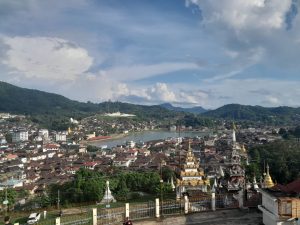Rebel forces in Myanmar have captured the strategically located gem-mining town of Mogok in Mandalay region, the Ta’ang National Liberation Army (TNLA) announced yesterday.
A spokesperson for the TNLA, which is part of the Three Brotherhood Alliance of ethnic armed groups, told Radio Free Asia that the group and its allies had seized control of the last four military camps in the town, which lies about 200 kilometers northeast of Mandalay, Myanmar’s second-largest city. “We have completed the occupation today,” she said.
Photos and videos posted on social media appear to show the town’s residents cheering the TNLA and its allies, including the Mandalay People’s Defense Force, as they move through a major thoroughfare in the town.
Late last month, the Three Brotherhood Alliance, which also includes the Myanmar National Democratic Alliance Army (MNDAA) and Arakan Army, ended a five-month China-brokered ceasefire and launched attacks on regime positions across Shan State and neighboring Mandalay Region.
All of these areas lie along the axis of the highway that connects Mandalay, Myanmar’s second-largest city, with the town of Muse on the Chinese border, the main conduit of overland trade between China and Myanmar. On July 3, the MNDAA also laid siege to Lashio, the largest settlement in northern Shan State and the home of the Myanmar military’s North Eastern Regional Command.
According to The Irrawaddy, anti-regime forces have now taken control of Kyaukme and Nawnghkio towns, both of which sit on the Mandalay-Muse highway. Over the weekend, the Three Brotherhood Alliance agreed to extend until July 31 a ceasefire with the junta in northern Shan State after “pressure” from China. But the ceasefire does not apply in Mandalay Region, where the fighting has continued.
At the start of the month, TNLA troops were photographed in the center of Mogok, but fighting around the town has continued. The fall of Mogok marks the loss of another node of junta control in the region, which now seems on the brink of slipping out of its control entirely.
These attacks are part of the second phase of the Three Brotherhood Alliance’s Operation 1027 offensive. Between its surprise commencement in late October and the ceasefire of early January, the first phase of the offensive made rapid and significant gains, capturing 18 towns and 36 military bases in the northern part of Shan State, including several important border crossings with China.
According to a briefing published yesterday by the International Institute for Strategic Studies (IISS), the purpose of the renewed offensive is to secure “buffer zones” around the territories that the TNLA and MNDAA captured during the initial phase of Operation 2017, in anticipation of a more robust junta counteroffensive.
As the IISS briefing points out, the current phase of Operation 1027 is taking place in considerably less auspicious conditions than the initial phase. First, while China supported the first phase of the offensive, and indeed, actively aided the MNDAA’s seizure of the Kokang Self-Administered Zone, in order to terminate the industrial-scale online scam centers operating in the region, it has been much less enthusiastic about its resumption, which it fears could lead to a total collapse of the junta’s position in Shan State. According to IISS, China has cut off water and internet services to the MNDAA’s territory, and suspended trade at all border gates controlled by the MNDAA and TNLA. It is largely due to Chinese pressure that these groups have agreed to a ceasefire until the end of July.
The second factor is the increasing friction between ethnic armed groups in Shan State. The rapid advances of the TNLA and MNDAA have brought them into closer proximity with rival groups. This has increased competition between these organizations, “driven by strategic imperatives, including the need to control lucrative resources, border crossings and corridors that the regime could utilize in a future counter-offensive.”
For instance, the current offensive has exacerbated the latent tensions between both the TNLA and the Kachin Independence Army and Shan State Progress Party (SSPP). As the IISS reports, the United Wa State Army, Myanmar’s largest ethnic armed group, has deployed a 2,000-strong force in Tangyan Township in order to block the advance of the MNDAA. This took place at the behest of both the Chinese government and the military regime in Naypyidaw. The SSPP, which like the UWSA had previously remained above the fray of the post-coup conflict, has also deployed forces in an effort to prevent gains by other groups.
All of this suggests that there might be natural limitations to how far the second phase of Operation 1027 can go. As David Scott Mathieson wrote this week in a cautionary article for Asia Times, “Unresolved tensions among armed Shan groups and with [Three Brotherhood Alliance] members could divert attention and resources from sustained fighting against the SAC.”
All of this is a reminder that the impressive territorial gains of the Three Brotherhood Alliance have brought with them mounting military, political, and diplomatic challenges. How these groups succeed in managing these challenges will go a long way to determining the ultimate course of the conflict in Myanmar’s largest state.

































